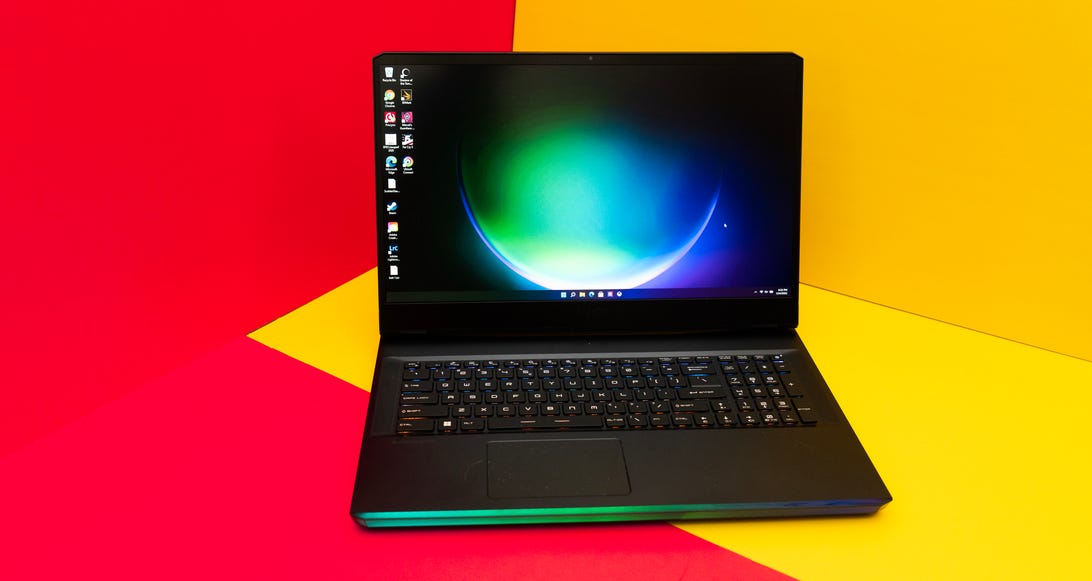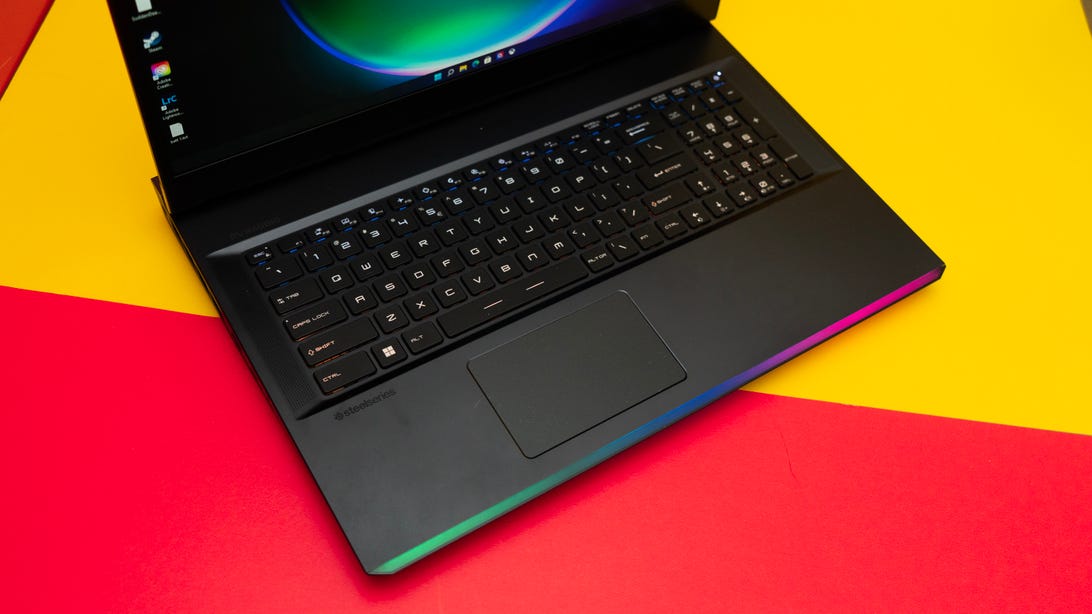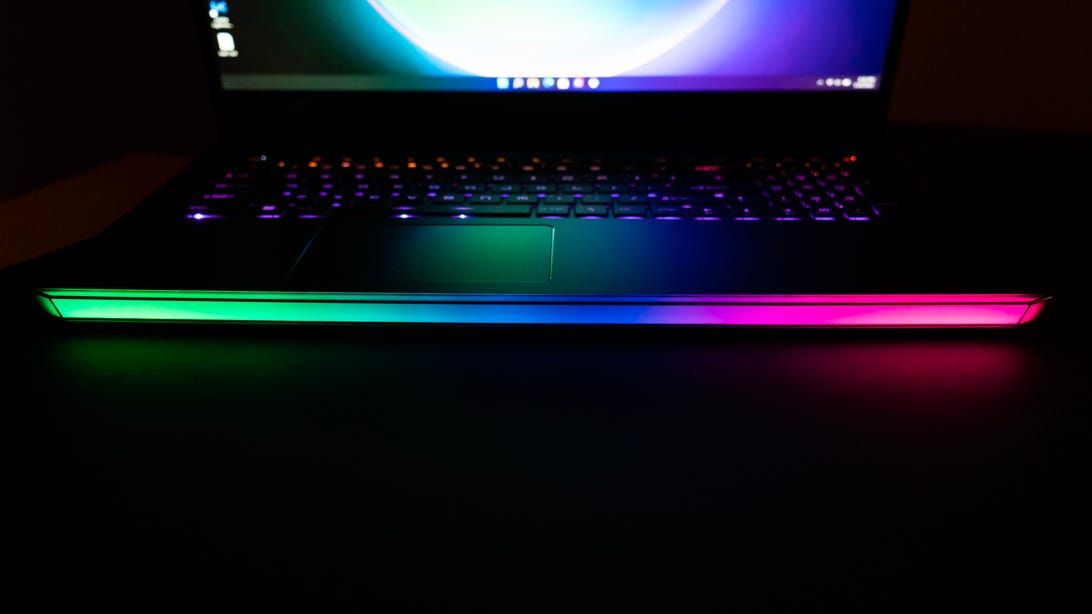
MSI’s top-end 17-inch Raider GE76 gaming laptop comes with state-of-the-art components that let it fly. It’s stacked with an Intel Core i9-12900HK CPU and Nvidia GeForce RTX 3080 Ti GPU. That processor is the newest Intel mobile Alder Lake architecture, which splits the cores into performance-optimized and efficiency optimized (like Apple’s M1 chips). And while the RTX 3080 Ti is just a new iteration of Nvidia’s top mobile GPU, the MSI shows how well it performs when you push it — and not even to the max — in a system that allows it to draw full power.
In other words, the components are performing better than they would on a laptop with a pretty thin-and-light design; those have to compromise on power for the sake of cooling, battery size and AC adapter size. The downside is that the Raider is a lot more traditional. It also lacks Nvidia’s Advanced Optimus, which is better at juggling the internal and discrete GPUs than the older version of Optimus used in the Raider GE76.
Like
- Fast
- Has a full array of connectors
Don’t Like
- Loud fans
- Doesn’t incorporate Nvidia’s Advanced Optimus
- Relatively small touchpad
The laptop’s display isn’t on the GPU bus, so the battery life is highly dependent on whether you remember to switch into hybrid mode. (In hybrid mode, the rendering and acceleration are performed by the Nvidia GPU and passed over the system bus to the CPU to render to the screen.) That means you have to manually force it to use the discrete graphics — it can’t toggle back and forth intelligently and automatically. MSI does have a utility that automatically switches in and out of “extreme” mode as you launch games.
On the other hand, this isn’t really a “laptop” laptop. It’s a desktop replacement, so I’m not sure how important a little extra battery life is. It’s big and relatively heavy, with one of those mondo power bricks that add another 2 pounds to the carry weight. It’s also loud, even in hybrid mode, though it doesn’t seem to run particularly hot. (Caveat: I haven’t done any overclocking-related testing yet, so it might well turn into a fireball.)
MSI Raider GE76
| MSI Raider GE76 | |
|---|---|
| Price as reviewed | NA (closest configuration is $3,999) |
| Display | 17.3-inch 360Hz |
| PC CPU | Intel Core i9-12900HK |
| PC Memory | 32GB DDR5-4800 |
| Graphics | Nvidia GeForce RTX 3080 Ti |
| Storage | 2TB NVMe SSD (with DirectStorage support), SD card reader |
| Ports | 4 x USB-A, 1 x USB-C/Thunderbolt, 1 combo audio, 1 x HDMI 2.1, 1 x Mini DisplayPort 1.4 |
| Networking | Killer Wi-Fi 6E AX1675, 2.5Gb Killer E3100 |
| Operating system | Microsoft Windows 11 Pro (21H2) |
| Weight | 6.4 pounds (2.9 kilograms) |
The few processor results I’ve gotten thus far also place it best in class (or close), by a significant margin in some cases. Single-core speed, traditionally Intel’s strong point, is also impressive. When you combine all the advances in GPU and CPU in the system, it becomes a powerhouse for video editing.


The Raider GE76 comes in about seven different configurations that range in price from $1,599 (with an i7-12700H, RTX 3060 and 1080p 360Hz display) to $4,199 (i9-12900HK, RTX 3080 Ti and 4K 120Hz display). Our test system configuration isn’t available here, but the closest option, with an i9-12900HK, RTX 3080 Ti and 1440p 240Hz display for $3,999 is actually better; 4K can be overkill for 17 inches and 1080p is OK, but QHD is just right. ($3,999 converts to approximately £2,970 or AU$5,600.)
Among the laptop’s performance-related perks is support for DirectStorage, Microsoft’s programming interface for high-bandwidth SSD file operations in Windows (and the Xbox Series X/S), that, combined with its Samsung SSD and PCIe 4 bus, delivers quite a nice score of 2,802 on 3DMark’s SSD performance test (we’re still building our database of comparison numbers). MSI’s also one of the first companies to partner with BlueStacks for its mobile-gaming-on-laptop technology, which lets you play games designed for phones on the laptop as if they were written for the laptop — a bigger screen, high-power processing, full controller support and more. I haven’t yet tried that, but it sounds cool.


There’s a lot to unpack for this laptop which I haven’t yet been able to tackle, but I do have a couple of observations that I don’t think I’ll have a change of opinion on. For one, given the size of the laptop, the touchpad is ludicrously small, and I’m finding it intermittently nonresponsive. For the other, the SteelSeries keyboard feels mushy; quiet, but more like gel than membrane. I do like the laptop’s lighting design, but I’m a sucker for a lightbar (as well as underglow).
I’m still only a fraction of the way through my testing, so stay tuned for my upcoming final review.
Performance snapshot
Geekbench 5 (multicore)
Asus ROG Flow X13 with XG Mobile
Alienware m17 R4
Asus ROG Strix Scar 15 (G533QS)
MSI Raider GE76
Note:
Longer bars indicate better performance
Cinebench R23 CPU (single core)
Alienware m17 R4
Asus ROG Flow X13 with XG Mobile
Asus ROG Strix G15 Advantage Edition (G513QY)
MSI Raider GE76
Note:
Longer bars indicate better performance
Far Cry 5 (1080p)
Asus ROG Strix G15 Advantage Edition (G513QY)
Asus ROG Flow X13 with XG Mobile
Alienware m17 R4
MSI Raider GE76
Note:
NOTE: Longer bars indicate better performance (FPS)
Shadow of the Tomb Raider gaming test (1080p)
Asus ROG Strix G15 Advantage Edition (G513QY)
Asus ROG Flow X13 with XG Mobile
MSI Raider GE76
Alienware m17 R4
Note:
Longer bars indicate better performance (FPS)
3DMark Time Spy
Asus ROG Strix G15 Advantage Edition (G513QY)
Asus ROG Flow X13 with XG Mobile
Alienware m17 R4
MSI Raider GE76
Note:
NOTE: Longer bars indicate better performance
3DMark Fire Strike Ultra
Asus ROG Flow X13 with XG Mobile
Alienware m17 R4
Asus ROG Strix G15 Advantage Edition (G513QY)
MSI Raider GE76
Note:
Longer bars indicate better performance
3DMark Port Royal
Alienware m17 R4
MSI Raider GE76
Note:
Longer bars indicate better performance
Procyon Video (Premiere Pro)
Asus ROG Strix G15 Advantage Edition (G513QY)
Asus ROG Flow X13 with XG Mobile
Alienware m17 R4
MSI Raider GE76
Note:
Higher scores indicate better performance
SpecViewPerf 2020 SolidWorks (1080p)
MSI Raider GE76
Asus ROG Flow X13 w/ XG Mobile
Note:
Longer bars indicate better performance (FPS)
Configurations
| Alienware m17 r4 | Microsoft Windows 10 Home (20H2); 2.4GHz Intel Core i7-10980HK; 32GB DDR4 SDRAM 2,933MHz; 16GB Nvidia GeForce RTX 3080 512GB SSD + 953GB RAID 0 |
|---|---|
| Asus ROG Flow X13 with XG Mobile | Microsoft Windows 10 Home (2004); 3.3GHz AMD Ryzen 9 5900HS; 6GB DDR4 SDRAM 4,266MHz; 4GB Nvidia GeForce GTX 1650 (16GB GeForce RTX 3080 mobile in XG Mobile) |
| Asus ROG Strix G15 AMD Advantage Edition | Microsoft Windows 10 Home (21H1); 3.3GHz AMD Ryzen 9 5900HX; 16GB DDR4 SDRAM 3,200MHz; 12GB AMD Radeon RX 6800M; 512TB SSD |
| MSI Raider GE76 | Microsoft Windows 11 Pro (21H2); 2.9GHz Intel Core i9-12900HK; 32GB DDR5 SDRAM 4,800MHz; 16GB Nvidia GeForce RTX 3080 Ti; 2 x 1TB NVMe SSD |



